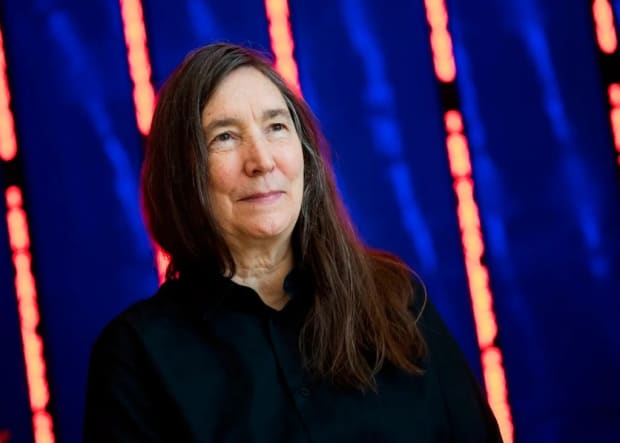-
Overview
I used language because I wanted to offer content that people - not necessarily art people - could understand.
Jenny Holzer, born on July 29, 1950, in Gallipolis, Ohio, is an esteemed American conceptual and installation artist whose groundbreaking use of text in public spaces has left an indelible mark on the art world. Holzer’s innovative approach spans various media, including electronic signs, carved stone, paintings, billboards, and printed materials, each serving as a platform for her thought-provoking messages.
Holzer’s educational journey laid the foundation for her unique artistic vision. She studied at Duke University, the University of Chicago, and Ohio University, where she earned a BFA. Further refining her craft, she participated in the Whitney Museum Independent Study Program. This diverse educational background influenced her multidisciplinary approach to art.
Holzer first garnered attention in the late 1970s with her "Truisms" series, a collection of aphoristic statements anonymously posted throughout New York City. This project established her signature style, using language to challenge perceptions and incite public discourse. Her texts, often direct and confrontational, address themes such as social justice, power dynamics, violence, and human vulnerability.
Throughout her career, Holzer has continually pushed the boundaries of conceptual art. Her iconic LED installations utilize scrolling texts to engage audiences in both intimate and expansive public spaces. In addition to electronic media, Holzer’s stone carvings and permanent installations merge textual art with sculptural form, creating enduring pieces that provoke reflection and dialogue.
Holzer’s work is distinguished by the tension she creates between emotion and intellect. Her texts juxtapose stark, factual language with deeply emotional content, exploring the complexities of human experience. This interplay underscores her commentary on both individual and collective realities, examining issues of power, violence, vulnerability, and tenderness.
Holzer’s contributions to art and public discourse have been widely recognized. She received the prestigious Golden Lion at the Venice Biennale in 1990, highlighting her influence and impact. Her works have been exhibited in major institutions such as the Guggenheim Museum, the Museum of Modern Art, and the Whitney Museum of American Art, and are part of prominent collections worldwide.
In addition to her exhibitions, Holzer’s projects often inhabit public spaces, reaching diverse audiences and fostering broader engagement with her work. Her large-scale projections on urban architecture and intimate installations in natural settings demonstrate her commitment to making art accessible and relevant to the public.
Jenny Holzer’s practice transcends conventional artistic boundaries, utilizing language as a powerful tool for social and political commentary. Her work continues to resonate deeply, challenging viewers to consider the complexities of power, justice, and human experience in contemporary society. Holzer’s remarkable career reflects her dedication to provoking thought and inspiring change through art.
-
New In Jenny Holzer Installation Art
-

-
Series

Jenny Holzer
Money creates taste…, 2015Porto Rose quartzite footstool
17 × 25 × 16 in
43.2 × 63.5 × 40.6 cm
Edition of 6Series: TruismsCopyright The ArtistCreated between 1977 and 1979, Truisms are concise phrases that encapsulate complex ideas in simple, often confrontational language. Holzer originally disseminated these texts anonymously on posters throughout New York City,...Created between 1977 and 1979, Truisms are concise phrases that encapsulate complex ideas in simple, often confrontational language. Holzer originally disseminated these texts anonymously on posters throughout New York City, blending them seamlessly into the urban environment. The anonymity and ubiquity of the posters encouraged passersby to engage with the statements on their own terms, reflecting on their meanings and implications.
The "Truisms" cover a wide range of topics, including politics, social norms, identity, and human behavior. Each statement is designed to be both provocative and ambiguous, encouraging multiple interpretations. Phrases like "ABUSE OF POWER COMES AS NO SURPRISE" and "PROTECT ME FROM WHAT I WANT" invite viewers to consider their own beliefs and the societal structures around them. This broad thematic scope ensures that the "Truisms" remain relevant across different contexts and eras, resonating with diverse audiences.
Holzer’s use of public space for the "Truisms" was a deliberate choice to reach a wide audience outside the confines of traditional art galleries. By placing these texts in everyday settings, she democratized access to art and provoked spontaneous public discourse. The simplicity and directness of the "Truisms" made them easily digestible, yet their content often challenged viewers to confront uncomfortable truths about society and themselves. This approach transformed mundane urban spaces into arenas for intellectual and emotional engagement.
The success of the "Truisms" series led Holzer to explore other mediums, including electronic signs, projections, and even T-shirts and mugs, further broadening the reach of her messages. The adaptability of the "Truisms" to various formats underscores their versatility and enduring impact. Whether displayed on a billboard, projected onto a building, or printed on everyday objects, the "Truisms" continue to engage and provoke audiences worldwide.
News






